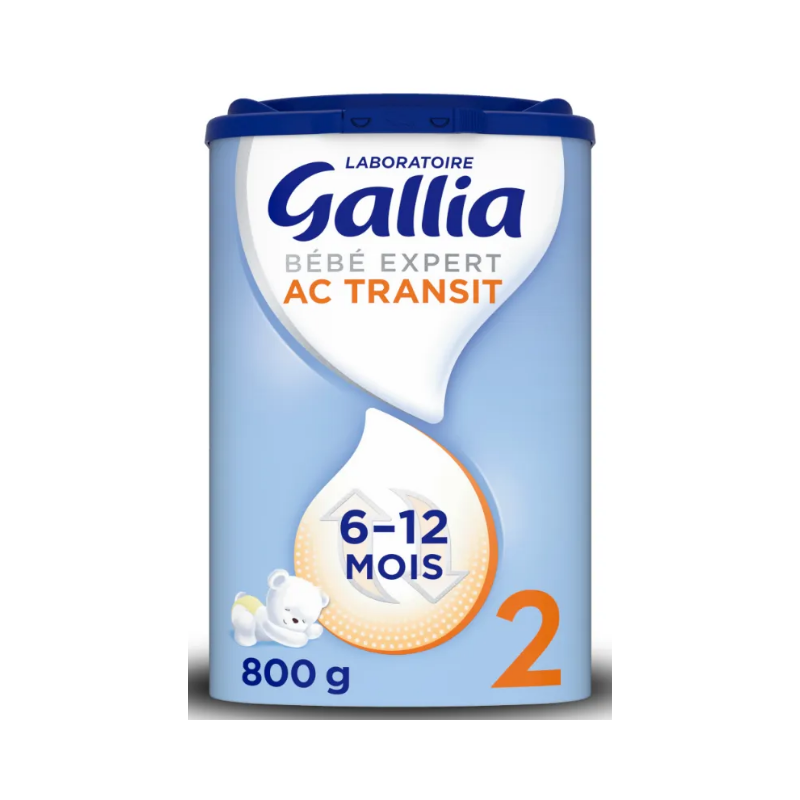To guarantee the quality of baby milks, they cannot be reimbursed or exchanged (just like medicines).
What does Gallia AC Transit provide?
The term colic is often used inappropriately. It is important to understand what colic is. A baby who cries excessively and unconsolably for more than 3 hours a day, more than 3 days a week for more than 1 week is called a colicky baby. This crying is not necessarily an expression of digestive discomfort. These colics generally begin around 15 days to 3 weeks of life, with a more marked peak at 6/8 weeks. They usually subside around 3 months and usually disappear between 4 and 5 months.
This formula contains partially hydrolysed proteins and dietary fibre of the FOS/GOS* type, which contribute to the management of colic and constipation.
*fructo-oligosaccharides and galacto-oligosaccharides
How to prepare
- Always wash your hands before preparing the bottles and your work surface. - Pour the required amount of cold water (bottled water recommended by your doctor) into a clean bottle. - Use the measuring spoon on the inside of the bottle. Add the corresponding number of scoops, using the rim of the can to remove the excess. - Put the teat in place and screw on the plastic ring. Shake horizontally and then vertically for about ten seconds. Unscrew slightly and allow to cool, then shake the bottle again. Check the temperature of the milk on the inside of your wrist. - After giving the bottle, clean it and the accessories with soapy water. Rinse thoroughly with clean water. Store the cleaned and closed bottle. - Practical: after each use, attach the measuring spoon to the spike under the lid.
The dosage and frequency of feeding are given as a guide. Every child is different, so listen to your baby and yourself. As a complement to breastfeeding, 30 ml is sufficient for the first few weeks of life. For example, from 2 to 4 weeks: for 1 bottle 90ml of water + 3 measuring spoons for 7 bottles per day / age of your baby 1 to 2 months: 120 ml of water for 4 measuring spoons and 6 bottles per day
Composition
Hydolisats of whey proteins (milk). Vegetable oils (palm, copra, rapeseed, sunflower) Glucose syrup fructo-oligosaccharides and Galacto-oligosaccharides Maltodextrin, starches, lactose, fish oil, choline chloride, Mortiella alpina, inositol, taurine, L-carnitine, nucleotide. Emulsifier: soya lecithin Antioxidant: ascorbyl palmitate Vitamins: A, D3, E, C, B1, B2, B3, B5, B8, B9, B6, B12, calcium pantothenate, K1 Minerals: Potassium iodide, sodium selenite, potassium, calcium and magnesium salts of orthophosphoric acid, calcium, potassium and sodium chlorides, iron, zinc, copper and manganese sulphates,
Important recommendations
- Prepare the bottle just before feeding. - For your baby's health, follow the preparation instructions carefully. - Only use the scoop contained in the Gallia 1st age box. - Do not hesitate to throw away the rest of the bottle. - After each use, replace the measuring spoon in the box and close the box with the lid. - Keep the box closed in a cool, dry place and use the powder within 4 weeks of opening. - Monitor your child's weight gain regularly.
Important notice
Breast or infant milk, the exclusive food of the first weeks of life, remains the basic food of the young child, even when his diet diversifies. Because of the nutritional requirements of infant growth, it is advisable to use milk for the second stage of development, specially designed for this period of life, until the age of 1 year. Follow-up milk cannot be used as a substitute for breast milk during the first 6 months of life. The decision to introduce complementary foods, especially before the age of 6 months, should only be made on the advice of a health professional.




